Sunflowers (Van Gogh series)
| Sunflowers | |
|---|---|
| Fourth version, exhibited at the National Gallery, London: Tourmesols | |
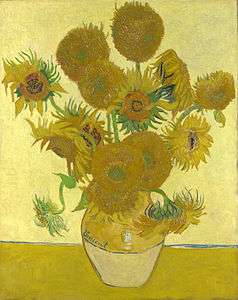 | |
| Artist | Vincent van Gogh |
| Year | 1888 |
| Catalogue | F454 |
| Medium | Oil on canvas |
| Dimensions | 92.1 cm × 73 cm (36.2 in × 28.7 in) |
Sunflowers (original title, in French: Tournesols) is the name of two series of still life paintings by the Dutch painter Vincent van Gogh. The earlier series, executed in Paris in 1887, depicts the flowers lying on the ground, while the second set, executed a year later in Arles, shows bouquets of sunflowers in a vase. In the artist's mind both sets were linked by the name of his friend Paul Gauguin, who acquired two of the Paris versions. About eight months later van Gogh hoped to welcome and to impress Gauguin again with Sunflowers, now part of the painted Décoration for the Yellow House that he prepared for the guestroom of his home in Arles, where Gauguin was supposed to stay. After Gauguin's departure, van Gogh imagined the two major versions as wings of the Berceuse Triptych, and finally he included them in his Les XX in Bruxelles exhibit.
The Paris Sunflowers
Little is known of Van Gogh's activities during the two years he lived with his brother, Theo, in Paris, 1886–1888. The fact that he had painted Sunflowers already is only revealed in the spring of 1889, when Gauguin claimed one of the Arles versions in exchange for studies he had left behind after leaving Arles for Paris. Van Gogh was upset and replied that Gauguin had absolutely no right to make this request: "I am definitely keeping my sunflowers in question. He has two of them already, let that hold him. And if he is not satisfied with the exchange he has made with me, he can take back his little Martinique canvas, and his self-portrait sent me from Brittany,[1] at the same time giving me back both my portrait[2] and the two sunflower canvases which he has taken to Paris. So if he ever broaches this subject again, I've told you just how matters stand."[3]
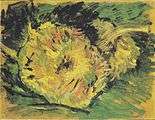
.jpg)


The two Sunflowers in question show two buttons each; one of them was preceded by a small study, and a fourth large canvas combines both compositions.
These were Van Gogh's first paintings with "nothing but sunflowers"—yet, he had already included sunflowers in still life and landscape earlier.

The Arles Sunflowers
In a letter to Theo, dating from 21 or 22 August 1888, Vincent wrote: "I'm painting with the gusto of a Marseillais eating bouillabaisse, which won’t surprise you when it's a question of painting large sunflowers." At this time he had three paintings on the go, and intended to do more; as he explained to his brother: "in the hope of living in a studio of our own with Gauguin, I'd like to do a decoration for the studio. Nothing but large sunflowers".[4]
Leaving aside the first two versions, all Arlesian Sunflowers are painted on size 30 canvases.
The initial versions, August 1888
None meets the descriptions supplied by van Gogh himself in his announcement of the series in every detail. The first version differs in size, is painted on a size 20 canvas—not on a size 15 canvas as indicated[5]—and all the others differ in the number of flowers depicted from van Gogh's announcement. The second was evidently enlarged and the initial composition altered by insertion of the two flowers lying in the foreground, center and right.[6] Neither the third nor the fourth shows the dozen or 14 flowers indicated by the artist, but more—fifteen or sixteen.[7] These alterations are executed wet-in-wet and therefore considered genuine rework—even the more so as they are copied to the repetitions of January 1889; there is no longer a trace of later alterations, at least in this aspect.
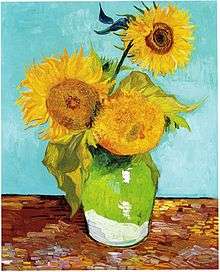 Sunflowers (F453), first version: turquoise background
Sunflowers (F453), first version: turquoise background
Oil on canvas, 73.5 × 60 cm
Private collection Sunflowers (F459), second version: royal-blue background
Sunflowers (F459), second version: royal-blue background
Oil on canvas, 98 × 69 cm
Formerly private collection, Japan, destroyed by fire in World War II on 6 August 1945[8] Sunflowers (F456), third version: blue green background
Sunflowers (F456), third version: blue green background
Oil on canvas, 91 × 72 cm
Neue Pinakothek, Munich, Germany Sunflowers (F454), fourth version: yellow background
Sunflowers (F454), fourth version: yellow background
Oil on canvas, 92.1 × 73 cm
National Gallery, London, England
The Repetitions, January 1889
 Sunflowers (F455), repetition of the 3rd version
Sunflowers (F455), repetition of the 3rd version
Oil on canvas, 92 × 72.5 cm
Philadelphia Museum of Art, Philadelphia, United States. Sunflowers (F458), repetition of the 4th version (yellow background)
Sunflowers (F458), repetition of the 4th version (yellow background)
Oil on canvas, 95 × 73 cm
Van Gogh Museum, Amsterdam, Netherlands.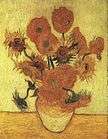 Sunflowers (F457), replica of the 4th version (yellow green background)
Sunflowers (F457), replica of the 4th version (yellow green background)
Oil on canvas, 100 × 76 cm
Sompo Japan Museum of Art, Tokyo, Japan.[9]
Both repetitions of the 4th version are no longer in their original state. In the Amsterdam version a strip of wood was added at the top—probably by van Gogh himself. The Tokyo version, however, was enlarged on all sides with strips of canvas, which were added at a later time—presumably by the first owner, Émile Schuffenecker.[10] The series is perhaps van Gogh's best known and most widely reproduced. In recent years there has been debate regarding the authenticity of one of the paintings, and it has been suggested that this version may have been the work of Émile Schuffenecker or of Paul Gauguin.[11] Most experts, however, conclude that the work is genuine.[12][13]
The Berceuse-Triptych

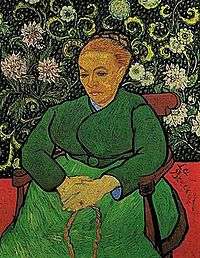


In January 1889, when Vincent had just finished the first repetitions of the Berceuse and the Sunflowers pendants, he told Theo: "I picture to myself these same canvases between those of the sunflowers, which would thus form torches or candelabra beside them, the same size, and so the whole would be composed of seven or nine canvases."[14]
A definite hint for the arrangement of the triptych is supplied by Van Gogh's sketch in a letter of July 1889.[15]
Later that year, Vincent selected both versions for his display at Les XX, 1890.
Sunflowers, friendship and gratitude

Van Gogh began painting in late summer 1888 and continued into the following year. One went to decorate his friend Paul Gauguin's bedroom. The paintings show sunflowers in all stages of life, from full bloom to withering. The paintings were considered innovative for their use of the yellow spectrum, partly because newly invented pigments made new colours possible.
In a letter to Theo,[16] Vincent wrote:
"It's a type of painting that changes its aspect a little, which grows in richness the more you look at it. Besides, you know that Gauguin likes them extraordinarily. He said to me about them, among other things: ‘that — ... that's... the flower’. You know that Jeannin has the peony, Quost has the hollyhock, but I have the sunflower, in a way."[17]
Subsequent history
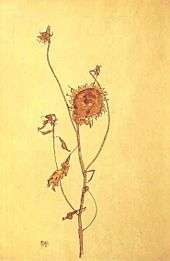
On March 30, 1987, even those without interest in art were made aware of van Gogh's Sunflowers series when Japanese insurance magnate Yasuo Goto paid the equivalent of US $39,921,750 for van Gogh's Still Life: Vase with Fifteen Sunflowers at auction at Christie's London, at the time a record-setting amount for a work of art.[18] The price was over four times the previous record of about $12 million paid for Andrea Mantegna's Adoration of the Magi in 1985. The record was broken a few months later with the purchase of another Van Gogh, Irises, by Alan Bond for $53.9 million at Sotheby's, New York on November 11, 1987.
While it is uncertain whether Yasuo Goto bought the painting himself or on behalf of his company, the Yasuda Fire and Marine Insurance Company of Japan, the painting currently resides at Seiji Togo Yasuda Memorial Museum of Modern Art in Tokyo. After the purchase, a controversy arose whether this is a genuine van Gogh or an Émile Schuffenecker forgery.
Provenances
Two Paris versions van Gogh exchanged with Gauguin in December 1887 or January 1888, were both sold to Ambroise Vollard: one in January 1895 and the other in April 1896. The first canvas resided for a short time with Félix Roux, but was reacquired by Vollard and sold to Degas from his estate to Rosenberg, then to Hahnloser and bequested to the Kunstmuseum Bern. The second was acquired by the Dutch collector Hoogendijk at the sale of his collection by Kann, who ceded the painting to Richard Bühler and then via Thannhauser to the Metropolitan Museum in New York.
Two of van Gogh's Sunflowers paintings never left the artist's estate: the study for one of the Paris versions (F377) and the repetition of fourth version (F458). Both are in the possession of the Vincent van Gogh Foundation, established 1962 by Vincent Willem van Gogh, the artist's nephew, and on permanent loan to the Van Gogh Museum, Amsterdam.
Five other versions are recorded in the Van Gogh estate papers:[19]
- the final Paris version (F.452) in the artist's estate was sold 1909 via C. M. van Gogh, The Hague (J. H. de Bois) to Kröller-Müller
- (F457) sold 1894 to Émile Schuffenecker. (Tokyo version).
- (F456) sold 1905 via Paul Cassirer to Hugo von Tschudi. (Munich version).
- (F459) sold 1908 C. M. van Gogh (J. H. de Bois), The Hague to Fritz Meyer-Fierz, Zürich (destroyed Japan 1945).
- (F454) sold 1924 via Ernest Brown & Phillips (The Leicester Galleries) to the Tate Gallery; since on permanent loan to the National Gallery, London. (London version).
Two Arles versions left the artist's estate unrecorded:
- (F453) (private collection). Sold 1891 to Octave Mirbeau, Paris, (via Tanguy, Paris) for £12 (about £1,300 in 2013 £). Sold 1996 to a private collector for an undisclosed sum.[20]
- (F455) (Philadelphia version).
Notes
- ↑ Wildenstein
- ↑ Selfportrait à l'ami Gauguin
- ↑ "Letter 571 - Vincent van Gogh to Theo van Gogh : 17 January 1889".
- ↑ Letter 666 To Theo van Gogh. Arles, Tuesday, 21 or Wednesday, 22 August 1888.
- ↑ Dorn 1990, pp. 336–337
- ↑ Dorn 1990, pp. 344–348
- ↑ Dorn 1990, pp. 337–340; 340–343 and Van Tilborgh & Hendricks, pp.
- ↑ "Vincent van Gogh: The Paintings (Still Life: Vase with Five Sunflowers)".
- ↑ "Seiji Togo Memorial Sompo Japan Nipponkoa Museum of Art".
- ↑ See Dorn 1999, pp.
- ↑ Johnston, Bruce."Van Gogh's £25m Sunflowers is 'a copy by Gauguin'". The Daily Telegraph, 26 September 2001. Retrieved on 3 October 2009.
- ↑ "Research confirms authenticity of Yasuda Sunflowers". Van Gogh Museum, 7 February 2002. Retrieved on 19 October 2012.
- ↑ "Van Gogh 'fake' declared genuine". BBC, 27 March 2002. Retrieved on 3 October 2009
- ↑ "Letter 574 – Vincent van Gogh to Theo van Gogh : 28 January 1889".
- ↑ "Letter 592 – Vincent van Gogh to Theo van Gogh : 22 May 1889".
- ↑ Letter 573
- ↑ Letter 741 To Theo van Gogh. Arles, Tuesday, 22 January 1889.
- ↑ Clines, Francis X. (1987-03-31). "Van Gogh Sets Auction Record: $39.9 million". The New York Times. Retrieved 2008-06-13.
- ↑ Dorn 1999 and Stolwijk & Veenenbos 2002
- ↑ Bailey, 2013, p. 202
References
- Bailey, Martin: The Sunflowers Are Mine: The Story of Van Gogh's Masterpiece, Frances Lincoln Limited (2013), ISBN 978-0-7112-3298-3
- Dorn, Roland: "Décoration": Vincent van Goghs Werkreihe für das Gelbe Haus in Arles, Georg Olms Verlag, Hildesheim, Zürich & New York, 1990, pp. 58–61, 73–80, 113–117, 335–348, 455–462 ISBN 3-487-09098-8
- Hoffmann, Konrad: Zu van Goghs Sonnenblumenbildern, Zeitschrift für Kunstgeschichte 31, 1968, pp. 27–58
- Eliza Rathbone; et al., eds. (2013). Van Gogh Repetitions. The Phillips Collection. ISBN 978-0-300-19082-3.
- Stolwijk, Chris, & Veenenbos, Han: The account book of Theo van Gogh and Jo van Gogh-Bonger, Van Gogh Museum, Amsterdam & Primavera Press, Leiden 2002 ISBN 90-74310-82-6
- Tellegen, Annet: Vincent en Gauguin: schilderijenruil in Paris, Museumjournaal 11, 1966, pp. 42–45
- Van Tilborgh, Louis & Hendriks, Ella: The Tokyo 'Sunflowers': a genuine repetition by Van Gogh or a Schuffenecker forgery?, Van Gogh Museum Journal 2001, pp. 17–43
- Welsh-Ovcharov, Bogomila: The Ownership of Vincent van Gogh's 'Sunflowers', Burlington Magazine, March 1998, pp. 184–192
External links
| Wikimedia Commons has media related to Sunflowers (van Gogh). |
- Sunflowers on Google Art Project
- Sunflowers at vggallery.com, the complete series of paintings.
- Sunflowers, vangoghgallery.com, offers an analysis of two sunflower paintings.
- The Munich version of Vincent van Gogh's Sunflowers at Neue Pinakothek on bavarikon
- Van Gogh, paintings and drawings: a special loan exhibition, a fully digitized exhibition catalog from The Metropolitan Museum of Art Libraries, which contains material on these paintings (see index)